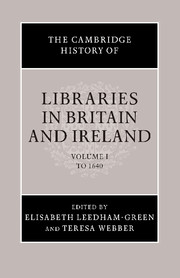Book contents
- Frontmatter
- Introduction
- The physical setting
- Part One The medieval library
- 2 Celtic Britain and Ireland in the early middle ages
- 3 Anglo-Saxon England
- 4 Monastic and cathedral book collections in the late eleventh and twelfth centuries
- 5 The libraries of religious houses in the late middle ages
- 6 College and university book collections and libraries
- 7 Bishops and kings: private book collections in medieval England
- 8 The medieval librarian
- 9 Borrowing and reference: access to libraries in the late middle ages
- Part Two Reformation, dissolution, new learning
- Part Three Tools of the trade
- Part Four Libraries for leisure
- Part Five Organisation and administration
- Select bibliography
- General index
- Index of manuscripts
- References
4 - Monastic and cathedral book collections in the late eleventh and twelfth centuries
from Part One - The medieval library
Published online by Cambridge University Press: 28 March 2008
- Frontmatter
- Introduction
- The physical setting
- Part One The medieval library
- 2 Celtic Britain and Ireland in the early middle ages
- 3 Anglo-Saxon England
- 4 Monastic and cathedral book collections in the late eleventh and twelfth centuries
- 5 The libraries of religious houses in the late middle ages
- 6 College and university book collections and libraries
- 7 Bishops and kings: private book collections in medieval England
- 8 The medieval librarian
- 9 Borrowing and reference: access to libraries in the late middle ages
- Part Two Reformation, dissolution, new learning
- Part Three Tools of the trade
- Part Four Libraries for leisure
- Part Five Organisation and administration
- Select bibliography
- General index
- Index of manuscripts
- References
Summary
The late eleventh and twelfth centuries witnessed a significant increase in the scale of book collections owned by monasteries and cathedrals. It was an achievement commemorated by twelfth- and thirteenth-century chroniclers, and is well attested by surviving books and records of book ownership. Such evidence permits a detailed examination of the contents and other aspects of these collections to an extent that is not possible for earlier centuries. In this respect, the period marks a turning point in the history of libraries in England, at least; a dearth of evidence remains for the rest of Britain and Ireland. More difficult to establish is the extent to which growth was accompanied by changes in the use and organisation of these collections, and developments in the concept of a library.
The marked growth in the holdings of religious communities was one aspect of a phenomenon common to western Europe during the later eleventh century and first half of the twelfth: a desire, expressed in various ways, to restore and perfect the form and practice of the religious life. It contributed to an unprecedented expansion in the number of religious communities. In England alone the number increased from sixty-one in 1066 to 400 by 1154. New or enlarged churches and other buildings, many in stone, were the most substantial and visible signs of the piety and patronage that lay behind such expansion, but books were also accorded a high priority. The obit composed for the liturgical commemoration of the achievements of Lanfranc, archbishop of Canterbury (d. 1089), for example, celebrates his endeavours to supply the community with ‘the precious gift of books, many of which he had corrected himself’, as an achievement second only to his enhancement of every part of the fabric of the cathedral priory.
- Type
- Chapter
- Information
- The Cambridge History of Libraries in Britain and Ireland , pp. 109 - 125Publisher: Cambridge University PressPrint publication year: 2006
References
- 1
- Cited by



